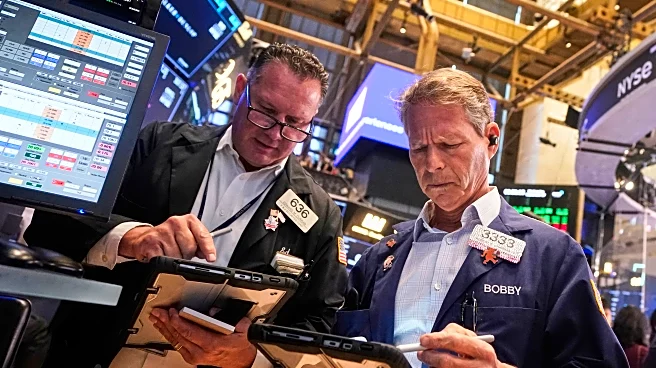What's Happening?
The Federal Reserve recently reduced interest rates by 25 basis points to a range of 4.00-4.25% in response to slowing economic growth and job gains, despite inflation remaining above target levels. This move has sparked expectations of further rate cuts, although concerns persist about ongoing high prices, particularly due to tariff-driven pressures. The U.S. inflation rate, as measured by the Consumer Price Index, rose by 2.9% year-over-year in August. Meanwhile, the stock market has experienced significant activity, with the S&P 500 up approximately 13% in 2025. Specific sectors have reacted to tariff news, with companies like Paccar and Eli Lilly seeing stock increases due to announcements affecting trucks and pharmaceuticals. Additionally, Boeing's stock rose following a substantial aircraft order from Uzbekistan.
Why It's Important?
The Federal Reserve's decision to cut interest rates is a critical measure aimed at stimulating economic growth and supporting the labor market. However, the persistence of inflation above the Fed's target complicates the economic landscape, as it limits the central bank's ability to aggressively lower rates. The impact of tariffs continues to be a significant factor, influencing both consumer prices and corporate strategies. Companies in sectors directly affected by tariffs, such as automotive and pharmaceuticals, are experiencing stock volatility. The broader market's response to these economic policies and trade developments highlights the interconnectedness of monetary policy, international trade, and corporate performance.
What's Next?
Looking ahead, the Federal Reserve is expected to continue monitoring economic indicators closely, with potential for additional rate cuts if growth remains sluggish. The ongoing impact of tariffs will likely be a focal point for both policymakers and businesses, as they navigate the challenges of maintaining competitive pricing and managing supply chain disruptions. Market participants will be watching for further announcements from the Fed and any changes in trade policy that could influence economic conditions. Additionally, corporate earnings reports and economic data releases will provide further insights into the health of the U.S. economy and guide future investment decisions.
Beyond the Headlines
The current economic environment underscores the delicate balance the Federal Reserve must maintain between fostering economic growth and controlling inflation. The interplay between monetary policy and trade dynamics presents both opportunities and challenges for businesses and investors. As companies adjust to the evolving landscape, strategic decisions regarding mergers, acquisitions, and capital investments will be crucial. The potential for increased consolidation in various industries, driven by lower capital costs, could reshape competitive dynamics and influence long-term economic trends.











